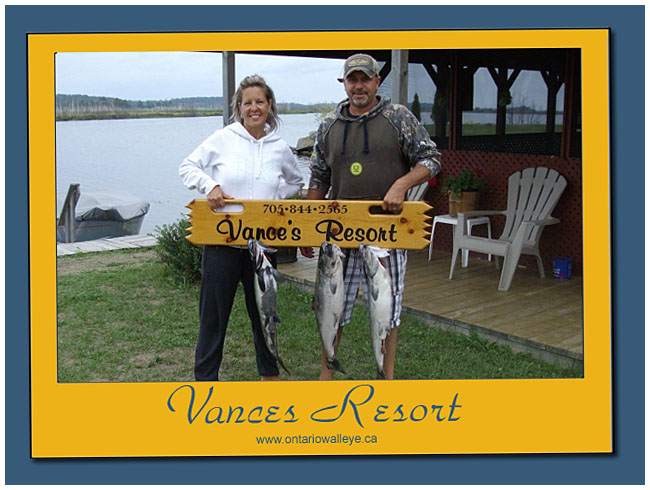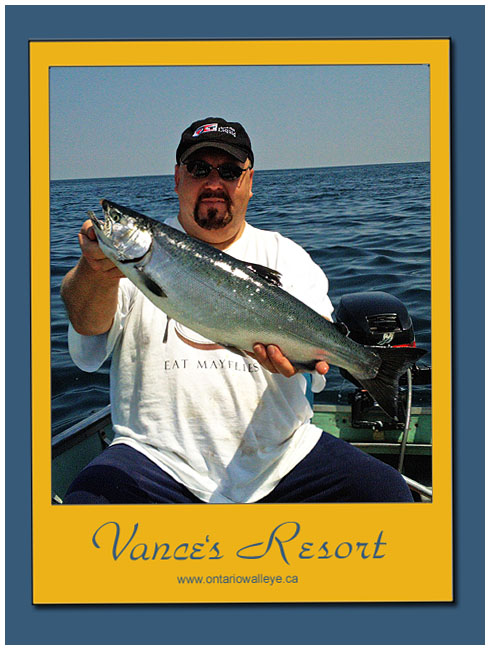
 In the summer, Coho Salmon and Chinook Salmon (King Salmon) are out in the deep water of Lake Huron and are generally only found by people who fish the lake all the time like local residents or professional fishing charters.
In the summer, Coho Salmon and Chinook Salmon (King Salmon) are out in the deep water of Lake Huron and are generally only found by people who fish the lake all the time like local residents or professional fishing charters.
In late summer and early Fall, great numbers of Chinook Salmon and Coho Salmon start staging at the mouth of the Spanish River or become more concentrated in the North Channel. Coming from the deep water of Lake Huron, the salmon are a nice color and great for eating. Later they go up the river to spawn. Coho can reach up to 20 pounds with the average size being around 12 pounds while the Chinooks can go over 40 pounds with the average size being about 20 pounds.
Many salmon hunters bring boats, which are geared with downriggers for the big lake. If you came for shallow fishing like Walleye or Pike and have a slow trolling boat, you can use our light-tackle deep-water fishing techniques, which are just as effective as downrigging for Salmon.
• View Regulations for the Spanish River (zone 10 - Adobe .pdf)
• View Regulations for North Channel & Georgian Bay (zone 14 - Adobe .pdf)
• View Big Map of North Channel
 Download Adobe .pdf Reader for Free
Download Adobe .pdf Reader for Free
Most of the information below can be used for west coast salmon fishing but most of my experience is on the Great Lakes.
There are three stages in which you can catch salmon. There is the Lake Stage, River Mouth Stage and the River Stage. First a brief background on Salmon.
In the Great Lakes there are different species of Pacific Salmon. The two most common are the Coho Salmon and Chinook Salmon. Chinook Salmon is also called a King Salmon on the west coast. There are some Kokanee and Pink Salmon but they are very rare and mostly found in Lake Erie. Atlantic Salmon are starting to be stocked.
Back in the 40's, 50's and 60's, misuse of fertilizer and industrial dumping of phosphate-based chemicals caused massive amounts of algae to grow in the Great Lakes. This increase of algae caused a massive population explosion of Smelt and Lake Shad. I remember when I was a kid, there would be 5 feet of dead fish on the shore of Lake Ontario before you could see water. This is the main reason why they started stocking salmon. They used salmon to feed on these massive populations of feeder fish. By the 70's, 40 pound Chinook Salmon were common because of all the food. You don't see that anymore. The average size Chinook is much smaller now. It's rare to see them over 30 pounds which is still a big fish.
On average, a Pacific Salmon lives to be four years old. It's just amazing that an egg which is 1/6 the size of your thumbnail can grow to such a large fish in four years. They have ferocious appetites. Coho Salmon are a smaller species and rarely get over 15 pounds.
 Lake Stage: Most people who fish the Great Lakes use bigger boats that tend to troll faster so the only way they can fish for salmon is with downriggers. In the Great Lakes, you will find that salmon that are feeding tend to hang-out in a 53 degree thermal layer which is where the bait fish usually are. Basically, you just have to mark fish on your fish finder and set your downriggers at different depths within 20 feet of where you are marking the majority of the fish. In the summer they can be 150 feet deep but as the summer moves on, the salmon start to come shallower.
Lake Stage: Most people who fish the Great Lakes use bigger boats that tend to troll faster so the only way they can fish for salmon is with downriggers. In the Great Lakes, you will find that salmon that are feeding tend to hang-out in a 53 degree thermal layer which is where the bait fish usually are. Basically, you just have to mark fish on your fish finder and set your downriggers at different depths within 20 feet of where you are marking the majority of the fish. In the summer they can be 150 feet deep but as the summer moves on, the salmon start to come shallower.
The best lures that have worked for me in the Great Lakes while fishing deep are William's Wabblers, Nasty Boys, Rapalas, Thunder Sticks, Sutton Silver Spoon and Cleos.
I personally don't like fishing with downriggers. I have a smaller boat so I can troll slow. Being able to troll slow, I can fish deep with a three-way-swivel rig which I explain on our Rainbow Trout page. It's much more fun then downriggers.
River Mouth Stage: In late summer and early fall, the salmon start staging at the mouth of rivers. They are waiting for the rain to make the water level high enough so that they can swim up stream and spawn. I fish off Bronte Peer in Oakville, Ontario and I see different people doing different things. Some people use spawn bags with a little Styrofoam in them to make them float. Just cast out with a sinker and let the spawn bag float off bottom. I also see people use Marsh Mellows. They will work sometimes but I find 90% of the time, these people are fishing in murky water and the salmon is just getting the line running across it's mouth and when the fish takes off, the hook catches up to the mouth giving the illusion that the salmon hit the bait. I also see people fishing this way snag a lot of fish because the hook snags their tail before it can catch up to the mouth.
I do see guys casting and trolling off the river mouths and legally catch salmon. The salmon will hit other lures but I think at this time of year, the salmon are aggressive and agitated and tent to hit rattle baits more then anything. I think the noise that rattle baits make ticks them off and they hit the lure. I have seen people get salmon on green, red and purple but the guys who get the most salmon were using white, silver or gold.
River Stage: Once the salmon go up small streams, they stop feeding. In a bigger river like the Nipigon River ro the Niagara River, The salmon will still feed for the first few days in the river. 99% of salmon that are caught in a small stream are snagged. People fish like they are fishing for Rainbows and just wait for the hook and line to cross the salmon's mouth which again, gives the illusion that the salmon was caught legally. But not all salmon are snagged. Salmon have nothing on their minds beside spawning. At this time, they are very aggressive and territorial and will defend their spawning ground from Rainbow and Brown Trout which tent to follow salmon up stream to feed on their eggs. If you throw a Rapala or spinner that has Rainbow or Brown Trout colours, the salmon will hit the lure. They do not hit to feed, they hit to defend. Sometimes they will also hit loud colours such as bright red or bright yellow.
Once the salmon start to swim up stream, they genetically start to disintegrate. Usually by the time they finish spawning, they are almost dead. Atlantic salmon do not die after they spawn.